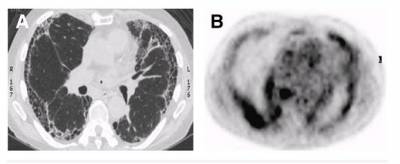Interstitial Lung Disease (ILD) is a chronic, debilitating condition characterised by both architectural and functional alterations in lung parenchyma. Currently HRCT is the gold-standard modality for assessing the fibrotic and inflammatory components associated with the condition, the latter which has been shown to predict outcome and treatment response.
Previous investigations into the application of PET/CT in ILD, undertaken both here and at other centres for excellence, have revealed that even the more fibrotic, less inflammatory areas of lung parenchyma exhibit increased glucose metabolism which is contrary to previous theory that the established fibrotic changes observed in the parenchyma were associated with dead tissue.
Our work is focussing on two specific classes of
interstitial lung diseases, the mixed fibrotic and inflammatory
Non-Specific Interstitial Pneumonia (NSIP) and the predominantly
fibrotic Idiopathic Pulmonary Fibrosis (IPF), both of which vary
considerably in both therapeutic response and overall prognosis. In both
entities, we are looking to assess the prognostic value of PET/CT in
ILD by correlating scan findings (SUVmax in co-registered fibrotic
areas) with Pulmonary Function Tests (PFT) and Quality of Life (QOL)
assessment. Our NSIP work is specifically looking at assessing PET/CT as
a tool for monitoring therapeutic response. An exciting project,
working in collaboration with GSK, will be commencing in October 2012 in
which we will utilise PET/CT to assess the pharmacokinetics of an
investigational drug which is expected to target and limit progression
of IPF.

Parenchymal honeycombing (UIP) on HRCT (A) with associated intense 18F-FDG uptake (B).
 Close
Close

